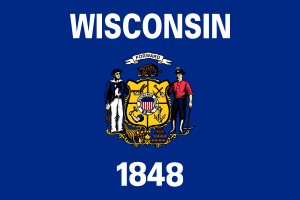I-90 Mississippi River Bridge
| I-90 Mississippi River Bridge | |
|---|---|
 Aerial View of the area looking south, with Lock and Dam No. 7 in the foreground | |
| Coordinates | 43°51′28″N 91°17′57″W / 43.85778°N 91.29917°WCoordinates: 43°51′28″N 91°17′57″W / 43.85778°N 91.29917°W |
| Carries |
4 lanes of |
| Crosses | Mississippi River |
| Locale | Dresbach, Minnesota to La Crosse, Wisconsin |
| Maintained by | Wisconsin and Minnesota Departments of Transportation |
| ID number | B-32-0045 (Wisconsin), 9320 (Minnesota) |
| Characteristics | |
| Design | Plate girder bridge |
| Total length | 2,490 feet (759 m) |
| Width | 67.3 feet (21 m) |
| Longest span | 450 feet (137 m) |
| Clearance below | 62 feet (19 m) |
| History | |
| Opened | October 1967 |


The I-90 Mississippi River Bridge is a plate girder bridge that connects La Crosse, Wisconsin to rural Winona County, Minnesota. It is an automobile bridge that traverses the Mississippi River, and is part of the Interstate 90 route. The railing consists of solid concrete; the steel structure is painted a dark green. There is another automobile crossing a few miles south of this bridge; the Mississippi River Bridge, a combination of two bridges, along with the La Crosse West Channel Bridge connect La Crescent, Minnesota and La Crosse, Wisconsin.
Potential rehabilitation or replacement
Although the current bridge has no weight restrictions and operates at an acceptable level of service, there are number of problems with the bridge and surrounding roadways:
- The deck is deteriorating, the most pressing issue in the short term.
- The bridge is of an obsolete, non-redundant structural design similar to that of the Hoan Bridge in Milwaukee, Wisconsin, which suffered a substantial structural failure. After the Hoan Bridge incident, the I-90 Mississippi River Bridge was hurriedly inspected and found to be in satisfactory condition, but concern about the basic steel structural design remains.
- A lack of standard shoulders inhibits emergency responses to incidents on the bridge and does not provide enough room for disabled vehicles to get out the traffic lanes.
- There are issues with the interchange on the Minnesota side, including a curve on the main travel lanes that is sharper than desirable for an interstate, a confusing design, and congestion on some of the ramps.
- There are capacity problems at the Dresbach Rest Area on the Minnesota sup side, which currently has only limited room for expansion. Compounding the problem, it is currently accessible from the eastbound direction, even though it is intended for westbound traffic only.
- There are no provisions for bicyclists and pedestrians on the bridge.
In 2006, Mn/DOT commissioned a study on ways to rectify some or all of these issues. Some of the options that were presented included:
- Replacing the deck only, estimated cost $23 million
- Widening and rebuilding the existing structure with either additional piers or strengthening the foundation, estimated cost $40–$58 million
- Building a new westbound girder bridge and converting the existing bridge to eastbound only, estimated cost $63 million
- Building a new girder bridge, extradosed bridge, or cable stayed bridge, and demolishing the existing one, estimated cost $59–$71 million
Selecting a preferred alternative will take further studies, but the least costly option that would address the non-redundant design of the existing bridge is $58 million, while the least costly total replacement option is $59 million. There are also a number of concepts for rebuilding the interchange on the Minnesota side, depending on whether the bridge is rebuilt or replaced. Complicating construction will be the proximity to steep bluffs and an active railway on the Minnesota side, proximity to the La Crosse Regional Airport, which could limit the height of any towers, and barge traffic, which restricts where piers may be placed. Construction is in progress with a planned completion date in late 2016.[1]
New bridge and interchange
The new crossing will consist of two separate bridges parallel and upstream from the existing bridge. They are concrete box girder structures over the main river channel and precast concrete girders over the back channel. The new bridges have will have the following specification:
- 100 year design life
- Length: 2593 ft
- Width: approximately 45-66 ft
- Two twelve-foot lanes each direction
- Eastbound acceleration lane
- Twelve-foot outside shoulders
- Six-foot inside shoulders
The final interchange will have no signals between I-90 and Hwy 61, as well as access to the traveler information center and boat launches. The westbound I-90 to southbound Hwy 61 will have a fly-under ramp allowing continuous movement with no competing traffic.[2]
Est. Cost: $187.5 Million

See also
-
 Bridges portal
Bridges portal -
 Minnesota portal
Minnesota portal -
 Wisconsin portal
Wisconsin portal - List of crossings of the Upper Mississippi River
- Lock and Dam No. 7